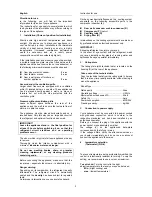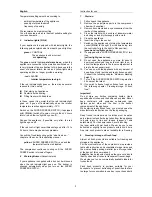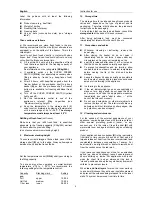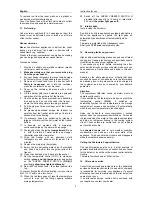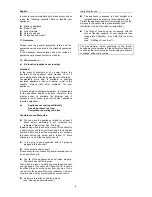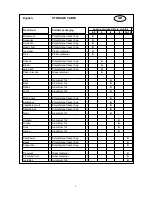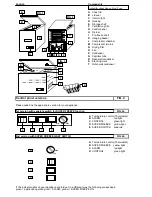
4
English
Label the portions with at least the following
information:
!"
Product name (e.g. beef fillet)
!"
Weight of portion
!"
Quantity (
total of pieces)
!"
Freezing date
!"
Use by date (
consumption date)
(
see “storage
table”)
Then continue as follows
a) We recommend you place fresh foods in the pre-
freezing compartment at the side
(I)
(not all models are
equipped) or on the bottom of the freezer. This is the
coldest part.
Avoid to put fresh foods directly in contact with deep
frozen food. Deep frozen food could defrost and may
not outlast the foreseen storage time.
b) Fill in within 24 hours, only the quantities of fresh
food that are suitable for the freezing capacity of
your appliance.
See information on the rating plate
(XX kg/24h)
.
c) If available, switch on the SUPER FREEZE
SWITCH
(FIG.4)
(not absolutely necessary when
filling in already frozen (e.g. deep-frozen food)
items.
d) After 24 hours, shift deep-frozen goods from the
freezer bottom or the pre-freeze shelf to a hung
basket
(K),
so that the pre-freeze shelf or freezer
bottom are available for freezing additional fresh
foods.
e) Turn off the SUPER FREEZE SWITCH (yellow
light goes off).
f) Set the temperature control to one of the
appliance’s relevant filling capacities (
see
“Maximum stacking height”).
g) Keep the temperature in the storage shelf (E)
under control, preferably by placing a thermometer
with a scale range of up to –26°C.
The storage
temperature must always be at least -18°C.
Refilling of fresh food (not frozen)
Make sure that you refill fresh food, in quantities
adequate to the freezing capacity (XXkg/24h) earliest
24 hours after the previous filling.
(do not exceed maximum stacking height)
9
Maximum stacking height
To ensure correct storage of frozen food, never fill the
storage shelf
(E)
up to the edge. Always allow space
between the lid and the frozen foods.
Set the temperature control
(FIG.4)
strictly according to
the filling capacity.
To save energy when operating in normal ambient
temperature (+18 to + 22°C), we recommend the
following settings for the temperature control:
Capacity Stacking
mark
Setting
pos.
Full
upper
12,00
h
Half
full
medium
10.00
h
1/4 or less
lower
08.00 h
Instruction for use
10 Storage
time
The storage time for purchased deep-frozen products
varies and depends on the type of product and its
packaging. Therefore, strictly observe the producer’s
instructions on the packaging.
For fresh food that you like to deep freeze, consult the
storage
table
at the back of this user manual.
After being defrosted, food must be consumed
immediately but latest within the next 24 hours.
11 Precautions and advice
!"
Whenever cleaning or defrosting, remove the
power plug.
!"
After closing the freezer lid, do not open it
immediately and do not force it open under any
circumstances. Any vacuum remaining on the
!"
seal (B) is released after about 1 or 2 minutes, so
that the lid can be opened normally once again.
!"
To prevent condensation and ice forming, allow
cooked food to cool down to ambient temperature
before closing the lid of the dish and before
storage.
!"
Leave the freezer lid open as briefly as possible to
avoid waste of energy and to prevent an excessive
amount of ice forming in the appliance.
!"
ice forming in the appliance.
!"
If the red indicator-light goes on unexpectedly or
stays on for a long period, do not open the lid on
any account and take the appropriate measures
immediately (
see guide “what is when ....” at the
back of the this user manual)
.
!"
Do not use a screwdriver or other metal objects to
remove the layer of ice. The interior walls are very
delicate and will not tolerate any sharp edges. Use
only plastic or wooden scrapers.
12 Cleaning and maintenance
For the upkeep of the external appearance of your
appliance, now and again clean with furniture polish or
other enamel protecting product (never, on any
account, use it in the inside. Clean the seal
(B)
with
warm water now and again without using any cleaning
product.
If your appliance has a condenser
(R)
in the rear inside,
from time to time remove dirt and dust. Dust and dirt
impede release of heat from the inner compartment and
considerably increases consumption of energy. For
best results, use a light brush or duster to remove dust
from the condenser on the rear wall.
If you leave your appliance out of use for an extended
period (e.g. when on holidays), leave it open to prevent
odours building up inside. For appliances with locks:
when the chest lid is open, always set the lock in
“closed” position and keep the key well away from small
children to prevent accidents.
When
ice and frost layers
form on the inner walls up
to a certain thickness, they act as an insulation element
and prevent the coldness being released from the inner
walls. They must be removed from time to time.


